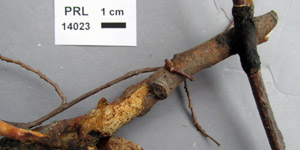See the Miettinen et al. (2019) paper; a free PDF is available at link below. Analysis of ITS and nrDNA tef1 sequences along with morphological and biogeographic data sorted out most of the species. Lectotypes were designated where needed to stabilize names. The synonymy in this group was investigated. Notably some names of glue crusts
previously assigned as synonyms to H. corrugata, including H. agglutinans, are now thought to be synonyms of H. olivacea.
So, take note, a crust fungus gluing branches together cannot be assumed to be H. corrugata. Our other species of Hydnoporia have this ability.
There are fourteen accepted species listed formally by Miettinen et al. (2019) with new combinations into Hydnoporia. They estimate there are 20 or more species (northern hemisphere).
Taxon Details and Links
Nomenclature
-
Hydnoporia
Murrill,
North American Flora 9 (1): 3 (1907).
Type
- Sistotrema fuscescens Schwein.,
Schriften der Naturforschenden Gesellschaft zu Leipzig 1: 102 (1822), type: North Carolina.
A synonym [designated by Banker (1914)] of Sistotrema olivaceum Schwein.,
Schriften der Naturforschenden Gesellschaft zu Leipzig 1: 101 (1822), type: Pennsylvania.
Synonyms
-
Pseudochaete
T. Wagner & M. Fisch.,
Mycological Progress 1: 100 (2002).
Type: Auricularia tabacina Sowerby, Coloured Figures of English Fungi 1: 14, t. 25 (1797). Illegitimate.
Non Pseudochaete W. West & G.S. West (1903)
[green algae].
-
Hymenochaetopsis
S.H. He & Jiao Yang,
Mycological Progress 15: 2 (2016).
Replacement name for Pseudochaete.
Taxonomy
More name changes! In this case some species were split out of Hymenochaete over the years.
One, H. olivacea, went to Hydnochaete. But that genus is sunk back in Hymenochaete.
Then a different species, H. tabacina, went into a new separate genus named Pseudochaete.
The problem? There is already a Pseudochaete genus that is a green alga (so part of the same botanical and fungal code).
So they then published a replacement genus name, Hymenochaetopsis.
Turns out that "olivacea" is related to "tabacina" so it was also moved to Hymenochaetopsis along with other species.
Now this new paper shows that we actually should use the genus name Hydnoporia because it was published earlier based on a synonym of "olivacea." Hope that is more clear than mud.
The genus Hydnochaete, with type H. badia, is a synonym of Hymenochaete. But our common brown toothy crust recently known as Hydnochaete olivacea is now named Hydnoporia olivacea, and its synonyms include:
Hydnoporia fuscescens (Schweinitz) Murrill,
Hymenochaete agglutinans Ellis,
Hymenochaete episphaeria (Schweinitz) Massee,
Irpex cinnamomeus Fries,
and
Irpex quisquiliaris Patouliard.
Thus H. olivacea is also a glue crust.
Descriptions
- Gary Emberger:
Hydnoporia olivacea.
- Gary Emberger:
Hydnoporia tabacina.
- I could not find photos of Hydnoporia diffisa.
References
- Ainsworth, A.M., and A.D.M. Rayner. 1990.
Aerial mycelial transfer by Hymenochaete corrugata between stems of hazel and other trees.
Mycological Research 94: 263-266.
doi: 10.1016/S0953-7562(09)80625-4.
- Corfixen, P., and E. Parmasto. 2016.
Hymenochaete and Hymenochaetopsis (Basidiomycota) in Europe
Karstenia 57: 49-80.
doi: 10.29203/ka.2017.483.
- Miettinen, O, K.-H. Larsson, and V. Spirin. 2019.
Hydnoporia, an older name for Pseudochaete and Hymenochaetopsis, and typification of the genus Hymenochaete (Hymenochaetales, Basidiomycota).
Fungal Syst Evolution 4: 77–96.
doi: 10.3114/fuse.2019.04.07.
Article and PDF also online here:
PMCID: PMC7241676.
-
Wagner, T. and Michael Fischer. 2002.
Classification and phylogenetic relationships of Hymenochaete and allied genera of the Hymenochaetales, inferred from rDNA sequence data and nuclear behaviour of vegetative mycelium.
Mycological Progress 1: 93–104.
doi: 10.1007/s11557-006-0008-9.
- Yang, J., L-D. Dai, and S-H. He. 2016.
Hymenochaetopsis nom. nov. proposed to replace Pseudochaete (Hymenochaetales, Basidiomycota) with descriptions of H. laricicola sp. nov and H. gigasetosa new to China.
Mycological Progress 15:13 (8 pp.). doi: 10.1007/s11557-015-1153-9.
Photo Sources
- Hydnoporia glue crust,
Hymenochaete agglutinans
, Gary Lincoff:
Crust Fungi - garylincoff.com, (New York?).
- Hydnoporia glue crust, Tom Bigelow:
iNaturalist 16296525, New Jersey.
- Hydnoporia tabacina, boletebill:
Mushroom Observer 349160, Connecticut.
- Hydnoporia tabacina, P.R. Leacock, NAMA 2016-335
Mushroom Observer 264824, Virginia.
- Hymenochaete rubiginosa?, Jeff Skrentny, :
iNaturalist 62570773, Illinois.
Taxon links for 17793 Hydnoporia







